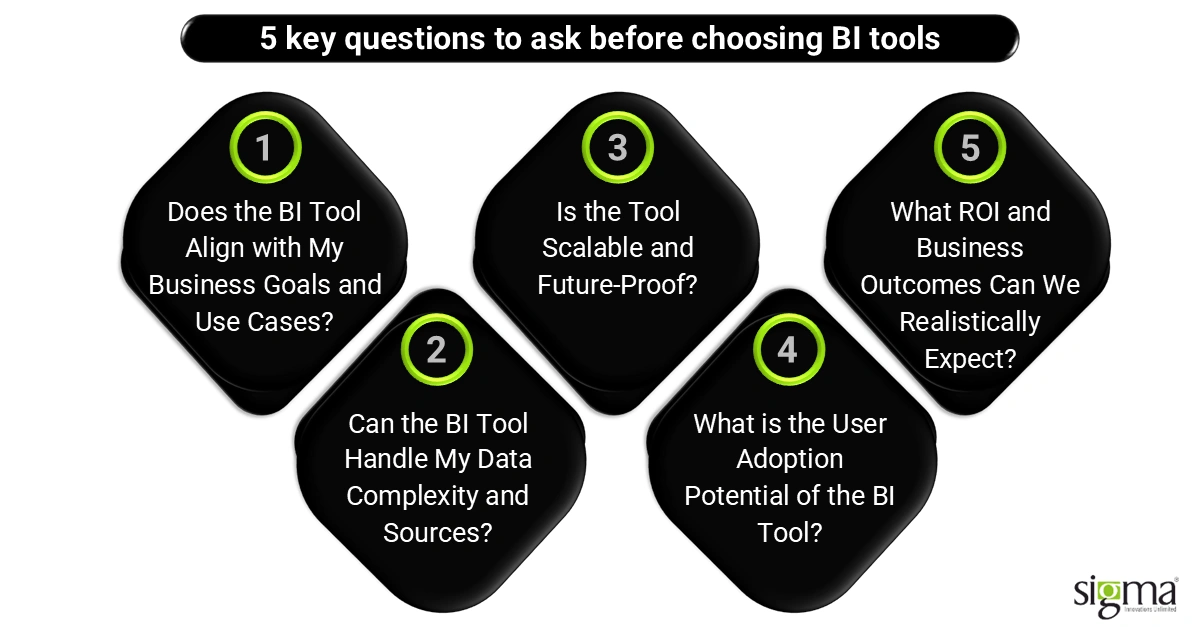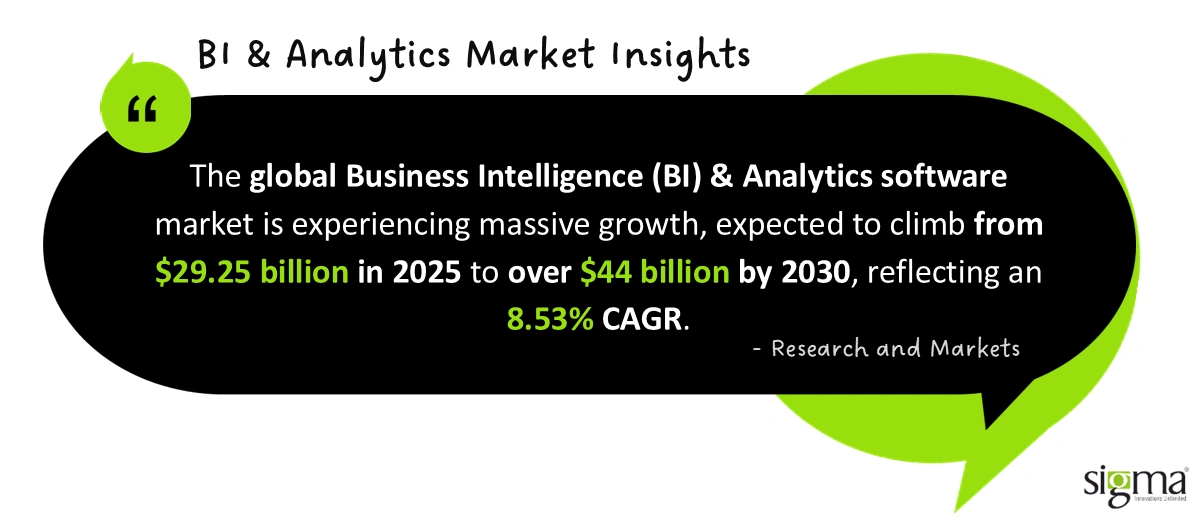5 Key Questions to Ask When Evaluating BI Tools
Key Takeaways:
- Don’t buy a sports car just to sit in traffic. Too many BI tools look sleek but fail to move the business forward. The right questions put your data in the fast lane.
- Stop patching leaks with duct tape. BI without strategy leads to silos, wasted spend, and frustrated teams. Asking the right questions seals the cracks before the flood.
- Think GPS, not just a map. A good BI tool isn’t about pretty charts; it’s about guiding decisions in real time. That starts with asking sharper, ROI-focused questions.
The value of a business intelligence tool in today’s economy goes far beyond its features; it lies in its ability to serve as the key to unlocking measurable business growth. For many CXOs and VPs, the temptation is to treat BI tools evaluation like shopping for office software: compare dashboards, look at pricing, and pick what seems “good enough.” But here’s the catch: when BI tool selection is reduced to a simple checklist, the result is often disappointing. Companies end up with business intelligence software that looks great in demos but creates more data silos, struggles with adoption, and ultimately drains budgets instead of driving insight.
The truth is, choosing the best BI tools requires a strategic approach. This is where business intelligence consulting services make the difference. Whether it’s aligning data insights with an eCommerce growth plan or ensuring compliance analytics in a fintech system, a well-guided evaluation delivers not just charts and dashboards but measurable business outcomes.
At Sigma Infosolutions, our BI and Analytics services are designed to help leaders avoid sunk costs and unlock ROI. In this blog, we’ll walk you through five key questions every decision-maker should ask when evaluating tools for business intelligence, a framework built to future-proof your analytics journey.

Question 1: Does the BI Tool Align with My Business Goals and Use Cases?
Too often, organizations fall into the trap of buying a business intelligence tool because it looks impressive in a demo. Flashy dashboards may win the room, but if the tool doesn’t map back to your actual business goals, it quickly becomes shelfware. In fact, according to Gartner, 80% of data & analytics (D&A) governance initiatives will fail by 2027.
The first step in BI tools evaluation is asking: Does this solution fit the way we actually operate?
Here’s what alignment looks like:
- eCommerce companies need BI and Analytics to optimize order fulfillment, reduce cart abandonment, and track customer journeys.
- Fintech and compliance-driven organizations need BI platforms that handle secure data modeling, real-time fraud detection, and regulatory reporting.
- Investment or SaaS firms look for predictive analytics and customer segmentation for smarter decision-making.
This is where customization matters. For example:
- Tableau development services can be tailored to give retailers visual insights into sales performance, seasonal demand, and customer preferences.
- Power BI development services excel for fintech companies where compliance dashboards, embedded analytics, and real-time alerts are critical.
Our business intelligence consulting services go beyond tool selection to help you align BI solutions with your organizational architecture so you don’t end up underutilizing powerful software. Our approach ensures your investment in business intelligence and analytics creates value across departments, not just eye-catching visuals.
Bottom line: A BI tool should act like the GPS for your business journey, guiding you to your strategic goals, not just showing you pretty maps.
Question 2: Can the BI Tool Handle My Data Complexity and Sources?
Modern enterprises don’t live in a single system anymore. You might have customer data sitting in Salesforce, transactions in your ERP, sales flowing through Shopify or Magento, and payments routed via multiple gateways. Without the right business intelligence software, this fragmentation creates:
- Data silos that hide the full picture
- Inconsistent reporting where departments argue over “which number is right”
- Missed insights that could otherwise drive growth or compliance
According to a recent study, businesses lose up to 20–30% of revenue every year due to poor data quality and silos.
That’s why during BI tools evaluation, you must ask: Can this platform integrate all of my data sources, both structured and unstructured, without breaking my workflows?
Here are key factors to check:
- Integration capabilities: Does it support ETL, APIs, and real-time pipelines?
- Data formats: Can it manage databases, spreadsheets, clickstream data, and unstructured logs?
- Deployment options: Does it offer flexibility between cloud-native and on-premise models?
Practical examples include:
- Power BI development services combined with Azure to handle real-time fintech data, fraud detection, and regulatory alerts.
- Tableau development services connecting Shopify and Magento analytics to give eCommerce leaders a 360° view of customer behavior and fulfillment flows.
At Sigma Infosolutions, our business intelligence consulting services start with mapping your data architecture before recommending any tool. This ensures your business intelligence and analytics foundation is built for both today’s fragmented landscape and tomorrow’s growth.
Think of it like plumbing: if the pipes don’t connect properly, no matter how shiny the faucet looks, you’ll never get clean water.
Also Read: Software Product Design: Data Driven vs User Driven
Question 3: Is the Tool Scalable and Future-Proof?
One of the biggest mistakes in BI tools evaluation is picking a platform that works today but struggles tomorrow. Businesses often outgrow their business intelligence software either because licensing costs skyrocket as more users are added, or the tool simply can’t handle the increase in data volume. The result? Teams scramble to replace the tool just when they should be doubling down on insights.
To avoid this, think beyond today’s needs and ask: Will this BI tool scale as my business grows?
Here’s what scalability and future-proofing should cover:
- Users: Can the tool handle growth from 20 users to 500+ without performance issues or runaway licensing costs?
- Data volume: Does it support petabytes of structured and unstructured data without latency?
- Features: Is it flexible enough to adapt to new BI trends like AI-driven analytics, self-service dashboards, and embedded analytics in enterprise applications?
Consider these scenarios:
- A fintech startup scaling from 20 users to 500 requires an architecture that supports real-time analytics, secure access, and compliance reporting.
- An eCommerce brand expanding into new product lines needs BI that can integrate new sales channels while still delivering smooth customer insights.
At Sigma Infosolutions, our business intelligence consulting services help organizations evaluate scalability and map growth paths. Whether through Power BI development services for enterprise-scale deployments or Tableau development services for self-service analytics, we make sure your business intelligence and analytics investments become a foundation for long-term growth.
Think of scalability like building a skyscraper; you don’t start with the roof, you design the foundation to carry floors you haven’t even built yet.
Question 4: What is the User Adoption Potential of the BI Tool?
Even the best BI tools fail if your teams don’t actually use them. One of the most common reasons for low ROI in business intelligence and analytics projects is poor adoption. A tool might check every technical box, but if it feels clunky, confusing, or limited to “power users,” it won’t gain traction across the business.
The reality is simple: poor adoption = ROI collapse.
When selecting BI tools, evaluate whether the platform was designed for everyday users, advanced analysts, or IT-heavy workflows. Adoption potential comes down to a few critical factors:
- UI/UX simplicity: Is the interface intuitive enough for a business manager without heavy training?
- User persona fit: Is it built primarily for business users, data analysts, or IT teams?
- Mobile readiness: Can insights be accessed on-the-go, across devices?
- Visualization richness: Does it present data in engaging, actionable ways?
- Collaboration features: Can teams easily share dashboards, annotate reports, and work together on insights?
Consider these examples:
- Tableau development services excel for business teams thanks to a visual-first design that makes data exploration intuitive.
- Power BI development services shine for organizations deeply tied into the Microsoft ecosystem, where technical teams can leverage seamless integrations with Azure, Teams, and Excel.
At Sigma Infosolutions, our business intelligence consulting services go beyond deployment. We provide custom adoption frameworks and training programs to ensure your chosen tool becomes embedded in your business culture, not just licensed software sitting on a server.
Think of BI adoption like a gym membership; you only see results if people show up and use it consistently.
Question 5: What ROI and Business Outcomes Can We Realistically Expect?
One of the toughest challenges in BI tools evaluation is defining ROI. Too often, companies invest in business intelligence software for “better reporting” but fail to connect it to measurable outcomes. Without a clear ROI roadmap, BI projects risk becoming cost centers instead of growth engines.
To avoid this trap, decision-makers should ask: What business outcomes do we expect, and how will we measure them?
Here’s how to define and track BI ROI:
- Decision speed: Faster, data-driven decisions that cut delays in operations.
- Compliance cost reduction: Automating regulatory reporting to reduce audit hours and fees.
- Sales lift: Using predictive analytics to boost cross-sell and upsell opportunities.
- Customer retention: Tracking churn signals and acting before it’s too late.
- Fraud detection: Identifying anomalies in real time to prevent financial loss.
Key KPIs to measure along the way:
- Adoption rate → Are teams actually using the tool?
- Data latency → How quickly can insights be refreshed and acted upon?
- Decision-to-execution gap → How long does it take to act on a BI-driven insight?
Real-world examples include:
- eCommerce brands cutting fulfillment cycle times with BI dashboards that optimize logistics and inventory.
- Fintech companies are reducing compliance audit prep time with the help of AI-powered business intelligence solutions.
At Sigma, we build ROI into every engagement. Through our BI and Analytics services, including Tableau development services and Power BI development services, we ensure your BI investment delivers measurable business outcomes, not just pretty charts.
Think of ROI as the fuel gauge of your BI journey; without it, you’re driving blind.
Also Read: US FinTech Market Growth, Trends, and Forecast
Additional Considerations Beyond the 5 Questions
While the five key questions create a strong BI tool evaluation checklist, there are a few additional factors that often determine long-term success. Ignoring these can lead to hidden costs, compliance gaps, or limited scalability.
Here’s what else to keep in mind when selecting BI tools for businesses:
- Licensing & Total Cost of Ownership (TCO): Evaluate not just upfront licensing but also costs for scaling users, storage, and advanced features.
- Vendor support & partner ecosystem: Look at the strength of the vendor’s support network and availability of skilled partners like Sigma Infosolutions for business intelligence consulting services.
- Security, compliance, and governance: Especially for fintech and eCommerce, ensure the business intelligence software complies with regulations like GDPR, PCI DSS, or SOC2.
- AI & predictive analytics readiness: Future-proof your investment by checking if the platform supports machine learning models, natural language queries, and real-time analytics in BI tools.
At Sigma, we evaluate these factors as part of our BI and Analytics services, helping leaders choose tools for business intelligence that deliver secure, scalable, and future-ready results.
Sigma Infosolutions’ Role in BI Success
Choosing the right business intelligence tool is only half the battle; turning that tool into measurable business outcomes requires bridging the gap between strategy and execution. That’s where Sigma Infosolutions comes in.
We help organizations maximize their BI investments through a combination of consulting expertise and hands-on development services:
- Business intelligence consulting services: We guide leaders in evaluating business intelligence and analytics platforms, aligning them with business goals, and building a roadmap for ROI.
- Tableau development services: From custom visualizations to advanced dashboards, we design experiences that give eCommerce and retail leaders clarity on customer journeys, fulfillment cycles, and seasonal demand.
- Power BI development services: Leveraging the Microsoft ecosystem, we deliver real-time analytics, secure integrations, and compliance-ready reporting for fintech, lending, and financial services firms.
Our case highlights include:
- eCommerce: Helping retailers reduce abandoned carts by using predictive BI insights to identify friction points in the checkout process.
- Fintech: Improving fraud detection and compliance reporting by embedding Power BI into transaction monitoring systems.
At Sigma, we specialize in turning data chaos into actionable strategy. With a future-focused approach, our BI and Analytics services ensure that your investment in tools for business intelligence doesn’t just deliver dashboards; it builds a scalable foundation for growth.
Conclusion
Selecting a business intelligence tool isn’t about comparing flashy dashboards or the number of pre-built reports. It’s about laying a strategic foundation that powers smarter decisions, better compliance, and scalable growth. Too many organizations treat BI tool evaluation like a feature checklist—only to face silos, low adoption, and wasted spend.
By asking the five key questions about business alignment, data integration, scalability, adoption, and ROI, you can avoid these costly pitfalls. More importantly, you set your company up to realize the full value of business intelligence and analytics, turning raw data into actionable strategy.
At Sigma Infosolutions, we help leaders get this right. From business intelligence consulting services to tailored Tableau development services and Power BI development services, our BI & Analytics Development Services in the USA are designed to make sure your BI investment drives measurable outcomes, not just dashboards.
Ready to future-proof your BI strategy? Explore our BI & Analytics Development Services or connect with us today to schedule a BI evaluation workshop and turn data into your most powerful business asset.




